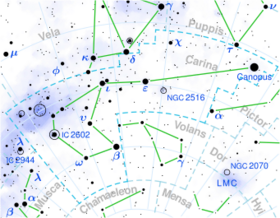Astronomy:Omega Carinae
| Observation data Equinox J2000.0]] (ICRS) | |
|---|---|
| Constellation | Carina |
| Right ascension | 10h 13m 44.21739s[1] |
| Declination | –70° 02′ 16.4563″[1] |
| Apparent magnitude (V) | 3.29[2] |
| Characteristics | |
| Spectral type | B8 IIIe[3] |
| U−B color index | –0.285[4] |
| B−V color index | –0.083[4] |
| Astrometry | |
| Radial velocity (Rv) | +7.0[2] km/s |
| Proper motion (μ) | RA: -36.01[1] mas/yr Dec.: +7.09[1] mas/yr |
| Parallax (π) | 9.54 ± 0.09[1] mas |
| Distance | 342 ± 3 ly (104.8 ± 1.0 pc) |
| Absolute magnitude (MV) | −1.81[5] |
| Details | |
| Radius | 7.20±0.14[6] R☉ |
| Luminosity | 918[7] L☉ |
| Surface gravity (log g) | 3.51[7] cgs |
| Temperature | 11,630[7] K |
| Rotational velocity (v sin i) | 240[7] km/s |
| Other designations | |
| Database references | |
| SIMBAD | data |
Omega Carinae, Latinized from ω Carinae, is a star in the constellation Carina. With a declination greater than 70 degrees south of the celestial equator, it is the most southerly of the bright stars of Carina (third-magnitude or brighter), and it is part of a southern asterism known as the Diamond Cross. This star has an apparent visual magnitude of 3.3 and is located at a distance of about 342 light-years (105 parsecs) from Earth.
Properties
Omega Carinae has a stellar classification of B8 IIIe,[3] which places it in the category of Be stars, that display emission lines of hydrogen their spectrum. Omega Carinae is a shell star,[3] having a circumstellar disk of gas surrounding its equator. The luminosity class of III indicates it has evolved into a giant star, having exhausted the hydrogen at its core and left the main sequence. The effective temperature of 11,630 K[7] in its outer envelope is what gives this star the blue-white hue that is characteristic of B-type stars.
This star is rotating rapidly with a projected rotational velocity of 240 km/s,[7] which gives a lower limit to the star's azimuthal velocity along the equator. The critical equatorial velocity, at which the star would begin to break up, is 320 km s−1. The star's axis of rotation is inclined by an estimated angle of 70.8° to the line of sight from the Earth.[9]
In the next 7500 years, the south Celestial pole will pass close to this star (AD 5800) and then I Carinae.[10]
In culture
In Chinese, 南船 (Nán Chuán), meaning Southern Boat, refers to an asterism consisting of ω Carinae, V337 Carinae, PP Carinae, θ Carinae and β Carinae .[11] Consequently, ω Carinae itself is known as 南船四 (Nán Chuán sì, English: the Fourth Star of Southern Boat.)[12]
References
- ↑ 1.0 1.1 1.2 1.3 1.4 van Leeuwen, F. (November 2007), "Validation of the new Hipparcos reduction", Astronomy and Astrophysics 474 (2): 653–664, doi:10.1051/0004-6361:20078357, Bibcode: 2007A&A...474..653V
- ↑ 2.0 2.1 Wielen, R. et al. (1999), "Sixth Catalogue of Fundamental Stars (FK6). Part I. Basic fundamental stars with direct solutions", Veroeffentlichungen des Astronomischen Rechen-Instituts Heidelberg (Astronomisches Rechen-Institut Heidelberg) 35 (35): 1, Bibcode: 1999VeARI..35....1W
- ↑ 3.0 3.1 3.2 Rivinius, Th.; Štefl, S.; Baade, D. (November 2006), "Bright Be-shell stars", Astronomy and Astrophysics 459 (1): 137–145, doi:10.1051/0004-6361:20053008, Bibcode: 2006A&A...459..137R
- ↑ 4.0 4.1 Gutierrez-Moreno, Adelina; Moreno, Hugo (June 1968), "A photometric investigation of the Scorpio-Centaurus association", Astrophysical Journal Supplement 15: 459, doi:10.1086/190168, Bibcode: 1968ApJS...15..459G
- ↑ Anderson, E.; Francis, Ch. (2012), "XHIP: An extended hipparcos compilation", Astronomy Letters 38 (5): 331, doi:10.1134/S1063773712050015, Bibcode: 2012AstL...38..331A
- ↑ Arcos, C.; Kanaan, S.; Chávez, J.; Vanzi, L.; Araya, I.; Curé, M. (2018), "Stellar parameters and H α line profile variability of be stars in the BeSOS survey", Monthly Notices of the Royal Astronomical Society 474 (4): 5287, doi:10.1093/mnras/stx3075, Bibcode: 2018MNRAS.474.5287A
- ↑ 7.0 7.1 7.2 7.3 7.4 7.5 Zorec, J.; Frémat, Y.; Domiciano De Souza, A.; Royer, F.; Cidale, L.; Hubert, A. -M.; Semaan, T.; Martayan, C. et al. (2016), "Critical study of the distribution of rotational velocities of be stars. I. Deconvolution methods, effects due to gravity darkening, macroturbulence, and binarity", Astronomy and Astrophysics 595: A132, doi:10.1051/0004-6361/201628760, Bibcode: 2016A&A...595A.132Z
- ↑ "ome Car -- Be Star", SIMBAD (Centre de Données astronomiques de Strasbourg), http://simbad.u-strasbg.fr/simbad/sim-id?Ident=omega+carinae, retrieved 2012-01-13
- ↑ Frémat, Y. et al. (September 2005), "Effects of gravitational darkening on the determination of fundamental parameters in fast-rotating B-type stars", Astronomy and Astrophysics 440 (1): 305–320, doi:10.1051/0004-6361:20042229, Bibcode: 2005A&A...440..305F
- ↑ Kieron Taylor (2005), Precession, http://moonkmft.co.uk/Precession.html, retrieved 2020-01-19
- ↑ (in Chinese) 中國星座神話, written by 陳久金. Published by 台灣書房出版有限公司, 2005, ISBN:978-986-7332-25-7.
- ↑ (in Chinese) AEEA (Activities of Exhibition and Education in Astronomy) 天文教育資訊網 2006 年 7 月 28 日
External links
 |


